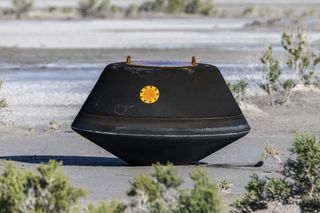Earth is constantly bombarded by fragments of rock and ice, also known as meteoroids, from outer space. Most of the meteoroids are as tiny as grains of sand and small pebbles, and they completely burn up high in the atmosphere. You can see meteoroids larger than about a golf ball when they light up as meteors or shooting stars on a dark, clear night. While very small meteoroids are common, larger ones – bigger than a dishwasher – are not. Meteoroids are difficult objects for aerospace and geophysics researchers like…
Read MoreTag: Asteroid & Comet Missions
NASA finally opens OSIRIS-REx asteroid sample canister after stuck lid issue
It’s finally open. After months of anticipation, NASA’s OSIRIS-REx mission has achieved a significant milestone by successfully accessing the treasure trove of asteroid material that the probe collected during its billion-mile journey. On January 10, a group of NASA technicians finally removed two stubborn fasteners that had locked away the precious cargo, allowing scientists unprecedented access to the asteroid material, according to a NASA statement. The OSIRIS-REx spacecraft made history in September 2023 when it became the first U.S. mission to return an asteroid sample to Earth. The sample was…
Read MoreNASA can’t wait for its OSIRIS-APEX spacecraft to meet ‘God of Chaos’ asteroid Apophis in 2029
NASA’s asteroid sampling spacecraft OSRIS-APEX will have an exciting new mission in 2029, when it will watch an exciting asteroid encounter like no other in recorded human history. The craft, formerly known as OSIRIS-REx, will bear witness as the asteroid Apophis— named after the ancient Egyptian god of chaos— comes so close to our planet that it could be visible with the naked eye in some parts of the world. After bringing a sample back from asteroid Bennu, the craft was recently rebranded the Origins, Spectral Interpretation, Resource Identification, and Security –…
Read MoreCrossed wires caused parachute problem during OSIRIS-REx asteroid sample delivery, NASA says
NASA thinks it knows why the OSIRIS-REx asteroid probe’s return capsule failed to deploy its drogue parachute as planned while descending through Earth’s atmosphere on Sept. 24. The problem, which did not prevent the capsule from landing safely and softly that day, was likely caused by crossed wires. “After a thorough review of the descent video and the capsule’s extensive documentation, NASA found that inconsistent wiring label definitions in the design plans likely caused engineers to wire the parachutes’ release triggers such that signals meant to deploy the drogue chute…
Read More